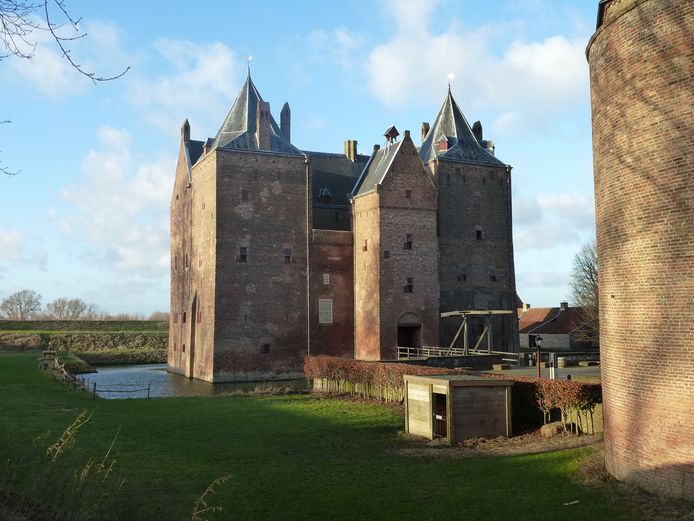Veerdienst Slot Loevestein
- De boottocht, via het water het slot naderen, is een onmisbaar leuk onderdeel van een bezoek aan Slot Loevestein en daarom heeft Riveer een speciale aanbieding op maat bedacht. Voor het traject Gorinchem of Woudrichem naar Slot Loevestein is er op de dagen dat er GEEN reguliere veerdienst vaart een speciale actie.
- Attractions near Loevestein Castle: (2.10 mi) Riveer Veerdienst (2.20 mi) Gorcums Museum (2.38 mi) Olala Chocola (2.26 mi) Grote Kerk Gorinchem (2.18 mi) Hendrick Hamel Museum; View all attractions near Loevestein Castle on Tripadvisor $.
- Riveer is a system of water taxis and ferry boats that connect a couple of nice towns and attractions in the Gorinchem region (like: Gorinchem, Woudrichem, Sleeuwijk and - during the summer seaon also - Loevestein Castle in Poederoijen). At the Gorinchem side there is a waiting room, box office and a small place to order snacks and have drinks.
Dec 12, 2012 Als het slot dicht gaat, stopt ook de eeuwenoude veerdienst tussen Loevestein en Woudrichem. Slot Loevestein - Duration: 5:29. Hans Groen 11,033 views. Oct 20, 2019 Loevestein Castle: Slot Loevestein (Castle Loevestein) - See 240 traveler reviews, 361 candid photos, and great deals for Poederoijen, The Netherlands, at Tripadvisor.
| Loevestein Castle | |
|---|---|
| Poederoijen, the Netherlands | |
Slot Loevestein | |
| Coordinates | 51°48′59″N5°01′17″E / 51.8164°N 5.0214°ECoordinates: 51°48′59″N5°01′17″E / 51.8164°N 5.0214°E |
| Type | Castle |
| Site information | |
| Open to the public | Yes |
| Condition | Good |
| Website | www.slotloevestein.nl |
| Site history | |
| Built | 1361 |
| Built by | Dirc Loef van Horne |
Loevestein Castle (Dutch: Slot Loevestein) is a medievalcastle in the municipality of Zaltbommel, Gelderland, the Netherlands.
The castle was built by the knightDirc Loef van Horne (hence 'Loef's stein' (stone) house) between 1357 and 1397. Until World War II Loevestein Castle was part of the Hollandic Water Line, the main Dutch defense line that was based on flooding an area of land south and east of the western provinces. Currently the castle is used as a medieval museum and function centre.

History[edit]
Loevestein is a water castle that was built between 1357 and 1368. It was built in a strategic location in the middle of the Netherlands, where the Maas and Waal rivers come together (just west of current day villages of Poederoijen and Brakel, in the municipality of Zaltbommel, in Gelderland). At first it was a simple square brick building, used to charge toll from trading vessels using the rivers. By 1372, the castle was under control of the Counts of Holland.[1] In the 16th century (around 1575, orders given by William the Silent) it was expanded to a larger fortress surrounded by earthen fortifications with two (later three) stone bastions on the northern side, two moats, an arsenal, and housing for a commander and soldiers. The Castle was also part of the Hollandic Water Line.
It changed hands twice between the Northern Dutch and the Spanish during the Eighty Years' War: on December 9, 1570, it was taken by the Geuzen; ten days later by the Spanish again; and on June 25, 1572, it was retaken by the Dutch.
See Full List On Slotloevestein.nl
From 1619 the castle became a prison for political prisoners. One famous inmate was the eminent lawyer, poet and politician Hugo de Groot (Hugo Grotius) often presented as the 'father of modern international law', who was serving a controversially imposed life sentence from 1619. In 1621, his wife Maria van Reigersberch, who was also staying at the castle, hid with him in a book chest that was regularly brought for them.[2][3] He subsequently became the Swedish Ambassador to France for 10 years. Another high-profile inmate was the English Vice-Admiral George Ayscue.


In literature[edit]
In Alexandre Dumas, père's novel La Tulipe Noire, the main character Cornelius Van Baerle is imprisoned at Loevestein.
See also[edit]
Gallery[edit]
Gunpowder tower at castle Loevestein.
References[edit]
- ^'The Middle Ages'. Loevenstein Castle. Retrieved 15 October 2017.
- ^Murray, John (1838). A hand-book for travellers on the continent: being a guide through Holland, Belgium, Prussia. BIBLIOBAZAAR. pp. 73. ISBN1-117-07017-4.
- ^Davies, Charles Maurice (2010). History of Holland, from the beginning of the tenth to the end of the Eighteenth Century, Volume 2. General Books. p. 539. ISBN978-1-151-01164-0.
Works cited[edit]
- Kransber, D; Mils, H. (1979). Kastelengids van Nederland, Middeleeuwen. Bussum. ISBN90-228-3856-0.
- Kalkwiek, K.A.; Schellart, A.I.J.M.; Jansen, H.P.H.; Geudeke, P.W. (1980). Atlas van de Nederlandse kastelen. Alphen aan den Rijn. ISBN90-218-2477-9.
- Helsdingen, H.W. van (1966). Gids voor de Nederlandse kastelen en buitenplaatsen. Amsterdam.
- Tromp, H.M.J. Kijk op kastelen. Amsterdam 1979. ISBN90-10-02446-6.CS1 maint: location (link)
- 'Loevestein Castle'. Holland.com.
Veerdienst Woudrichem-slot Loevestein
External links[edit]
| Dutch Rijksmonument10081 |
- Media related to Slot Loevestein at Wikimedia Commons